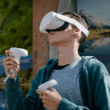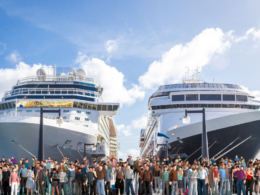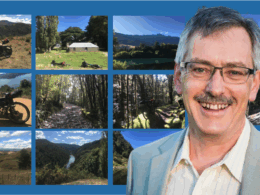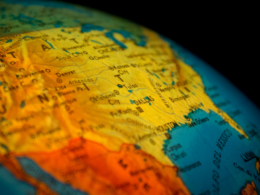Sustainable tourism is at a crossroad. There is a well-established link between tourism growth and environmental impacts. But there are competing interests at stake and proponents of continual growth are playing hard ball.
References
Radio New Zealand (2024). Is the value of cruise ships to New Zealand being overblown? Kathryn Ryan Nine to Noon (9.05am 18 November 2024). https://www.rnz.co.nz/national/programmes/ninetonoon/audio/2018964618/is-the-value-of-cruise-ships-to-local-economies
Steven Kennedy (30 August 2024) Secretary to the Treasury. Evidence informed policy making. Address to University of Adelaide, South Australian Centre for Economic Studies https://treasury.gov.au/speech/address-south-australian-centre-economic-studies-corporate-members-luncheon
Episode transcript
Recently my eyes have been opened to the tactics of industry organisations that have vested interests in continual tourism demand growth. This year I have been involved in two funded research projects that are recently completed and nearing publication. But with the findings of these research projects soon to be published, reports from industry organisations have been made public that present results that have raised a few eyebrows.
Earlier this year I embarked on a research project that examined the impacts of cruise tourism in New Zealand for the Milford Opportunities Project. The research had New Zealand-wide scope with particular focus on Otago/Southland and specifically on Piopiotahi Milford Sound. This was a collaborative project that involved a number of experts in a range of different fields. This was necessary because I adopted a ‘four capitals’ approach. In other words we wanted to undertake a deep dive analysis of the economic, social, cultural and environmental costs and benefits of cruise tourism.
It was a very interesting project that has produced a wide range of detailed insights – I personally think it is the most detailed and in depth critical analysis of cruise tourism ever conducted in New Zealand. One of my co-researchers was Dr. Ya-Yen Sun from the University of Queensland. Ya-Yen’s research addresses tourism sustainability, focusing on economic impacts and environmental footprinting. Her work on tourism economic impacts uses input-output modelling to provide very accurate quantitative estimates on spending, income, employment and GDP.
I invited Ya-Yen to lead the economic analysis because she is arguably the world expert on economic impact analysis. We embarked on this analysis with the assistance from Statistics New Zealand. Stats NZ previously produced annual analyses of the economic impacts of cruise tourism in New Zealand in the years prior to COVID-19 and provided expert advice on comprehensive data sources.
The report on cruise tourism in NZ was submitted to the government when the work of the Milford Opportunities Project was concluded, and remains embargoed until the recommendations of the MOP have been considered and decisions made by government.
You can imagine, then, that I was very interested when news broke of a report on the economic impacts of cruise tourism in New Zealand that had been produced by two industry bodies; the New Zealand Cruise Association and the Cruise Lines International Association. I first saw the news on Radio New Zealand at the start of November – timed perfectly to coincide with the start of the new cruise season.
The two industry bodies commissioned the report, according to RNZ, with the aim to provide the first comprehensive picture of the country’s cruise economy. I was fascinated to read that according to these industry bodies cruise tourism injected $1.37 billion into New Zealand economy in the last financial year. The report also claimed that direct spending by passengers, crew and cruise lines reached $637 million last financial year with an indirect benefit of $729.2 million. Close to 10,000 local jobs were supported by cruise tourism, providing $425.9 million in wages. Regional economic breakdowns were provided for Auckland, Otago, Canterbury, Bay of Plenty, and Wellington.
The same report popped up on Stuff which reported that the cruise industry was quote “celebrating bringing $1.37 billion dollars into the New Zealand economy”. Stuff reported that CLIA managing director in Australasia Joel Katz had claimed that the report gave the first comprehensive picture of New Zealand’s cruise economy, because it expanded on the data produced in past years by Stats NZ -precisely how it expanded on Stats NZ’s comprehensive analyses in previous years was not explained.
Aside from sectors such as retail, food and beverage, accommodation and transport providers, NZCA chief executive Jacqui Lloyd said cruise tourism is also supported by an extensive supply chain, creating benefits for New Zealand farmers and food producers, winemakers, providores and maritime service providers”.
The local media got in on the blanket coverage – the ODT reported that Otago and Southland coffers were boosted by $156 million from cruise tourism – the second highest figure of the 21 ports and destinations visited by cruise ships in New Zealand.
Just when I thought the saturation coverage had run its course, Port Otago ran a feature in the ODT claiming that cruise tourism was worth $187 millions to Otago and Southland – $31 million more than was reported a few days earlier from the same source! It claimed 1386 jobs created in the region and $59 million in wages to locals alone. What’s more 60% of cruise visitors return to the cities they visit as independent travellers – apparently – but what is the source of this figure? No one knows. All I can say that studies conducted overseas have completely dispelled such claims on return visitation.
****
Rocky waters on the horizon
These economic impact figures are clearly important to these organisations in terms of trying to justify cruise tourism to political decision makers in the face of growing local resistance. But they also serve the purpose of trying to persuade governments to reduce or remove regulations. Having celebrated the economic claims the various media reports segwayed to the claim that “rocky waters are on the horizon”.
Tourism Ticker reported the view of NZCA deputy chair Debbie Summers that quote “New Zealand has been complacent and that we are regulating in a fast and often ill-considered and uncollaborative manner.” And to quote again – “Surely, that’s the sector of tourism we want to put our arms around and actively encourage to be in our country?” Political leaders and gatekeepers needed to quote “do right by our country and do right by our people”, she said. “We need to support the New Zealand cruise industry, especially now we know what it’s worth.” Port Otago General Manager Custer, Craig Usher expressed the view that New Zealand was going backwards and local communities were facing reduced cruise passenger numbers because of it.
I submitted a request to receive the full report, so that methodology, data, and analysis could be reviewed to see if the research and the results being reported would withstand close scrutiny. The response was that only Cruise Association bronze members were eligible to receive the full report. So much for transparency. I wish I could provide insights into the results of our analysis but alas they remain embargoed. All I can say that our findings are very different to the findings reported by the NZCA and Cruise Lines International Association. Very different. Very different indeed.
****
The second study I refer to in this podcast is a three-year study led by Ya-Yen and a team of researchers who have produced the most extensive and comprehensive global tourism emissions analysis ever conducted. Covering 175 countries, the analysis includes global data from 2009 to 2020, the most recent year for which detailed data from national accounts is available – given that many countries stopped reporting on tourism data when COVID-19 pandemic occurred with such immediate and extreme consequences for tourism.
This research uses the ‘Measuring Sustainable Tourism’ framework that has been endorsed by the United Nations, producing emissions analyses by tourist type, producer, business/sector and by country. It provides very detailed insights into global tourism emissions, which have been shown previously to have represented 8% of total global emissions, growing at over 3% per annum, over double the rate of the global economy.
I wish I could provide insights into the results of our analysis but alas, although the paper was last week accepted for publication in Nature Communications – the top journal serving the field – and is now in production, we are not able to share the results until the paper is published online which we expect will be in about 2-3 weeks time. UN Tourism has expressed interest in our analysis and this week Ya-Yen will present the key findings at COP29 in Baku in Azerbaijan, with the permission of the journal.
Meanwhile, in a repeat of the tactics of the New Zealand Cruise Association and the Cruise Lines International Association, and with perfect timing ahead of COP29, the World Travel and Tourism Council (WTTC), the global tourism industry body, released its own quote “ground breaking environmental footprint data”. This was released at the WTTC’s 24th Global Summit in Perth, Western Australia last month. It is now reported on the WTTC website under the heading “WTTC reveals significant decrease in travel and tourism’s climate footprint emissions”.
It reports that the WTTC’s latest Environment and Social Research, conducted in partnership with the Ministry of Tourism of Saudi Arabia, reveals that in 2023 travel and tourism accounted for only 6.5% of all emissions globally, down from 7.8% in 2019 when travel and tourism was at its peak.
I quote here from the report: “The research showcases an important achievement with the sector’s economic contribution growing faster than its environmental impact”. “Our sector is proving that it can grow responsibly” said Julia Simpson who is the WTTC President and CEO. She claimed that “We’re decoupling growth from emissions”. These are very grand claims. They are based on research conducted by the WTTC, reported by the WTTC, to inform claims made by the WTTC – all in the interests of… the WTTC.
We were interested to see that it reports on 2023 even thought comprehensive data is not available for that year. So where is the report? It is available for close scrutiny? Has it been peer reviewed?
I will say two relevant things about our research forthcoming in Nature Communications. First – after three years of funded research, and following submission of our manuscript reporting methods, data and results in minute and totally transparent detail, our paper was subject to nearly a year of critical peer review and multiple rounds of questions, revisions and resubmission for further review. To say that the peer review process was meticulous – verging on forensic – would be an understatement.
And secondly, our results are very different to those presented last month by the WTTC. Very different. Very very different. Frustratingly – that is all I can say as of today.
****
Let me offer some concluding thoughts
It is important that independent academics engage in high quality science to produce rigorous and reliable insights that can inform the public and be usefully applied to informed government decision making and policy. By contrast, these reports are produced by industry bodies with deeply vested economic interests. They are not independent – these industry bodies and their members have much to gain from government – global, national and local – thinking that tourism contributes significantly to the economy (which they seek to play up) without significant social or environmental impacts, costs or risks (which they seek to down play). Who is peer reviewing these industry reports and the grand claims that they make? And why are the media reporting on the claims made by industry bodies without any critical engagement?
All of this confirms beyond any doubt that there is intense competition for influence. Industry organisations will pay for space in media and directly lobby governments. They will use ‘so-called research’ as the basis to make grand claims of economic contributions. Rarely if ever are these reports or the evidence-base – namely methods, data and analysis – made available for public scrutiny. I have never heard of any willingness to engage in independent peer review, as is the case in all forms of academic publication.
As for evidence-based policy making and the mechanisms of government. “Evidence-informed policy is a deliberate and rigorous approach that seeks to support policy with the best available insights, rather than intuition, ideology, anecdote, or short-term political (and economic) expediency” (Kennedy, 2024: 2). These industry reports do not contribute to the evidence-base. They should be treated only as industry lobbying. The government should recognise this, and the media should not report on such claims in such an uncritical manner.
Finally, as I footnote, I was very pleased to hear Kathryn Ryan take up the Cruise report on RNZ Nine to Noon this very morning. Well done to Peter Nuttall and Alison Newell who were interviewed and who raised their deep concerns about the Cruise Association. Peter is the scientific and technical advisor at the Micronesian Center for Sustainable Transport – the group behind a push for the International Maritime Organisation to implement a worldwide carbon levy on shipping. Alison Newell is a Chartered Environmentalist, director of Sailing for Sustainability based in Fiji.
They raised the very points that I have addressed here noting that the full report has been withheld from the public and the media has reported the information that has been provided to them in the form of infographics without any interrogation of the data and methods used or the motivations of an industry lobby group that seeks to self-justify – in the face of growing public cynicism – and to reduce regulation wherever possible. Well done Kathryn Ryan for taken up the baton. The full interview is referenced at the end of this transcript.
For now I really do look forward to being able to share the detailed insights from our own research in the coming weeks, when the embargo is lifted on our cruise report and when our paper on global tourism emissions is published online.








